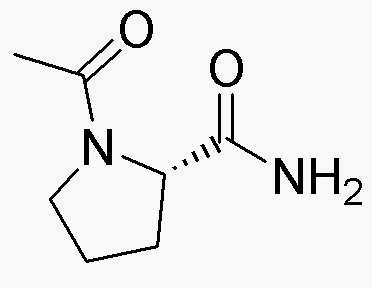Acetyl-L-proline amide is widely utilized in research focused on:
- Peptide Synthesis: This compound serves as a building block in the synthesis of peptides, particularly in the development of cyclic peptides, which are important in drug design and development.
- Pharmaceutical Development: It is used in the formulation of pharmaceuticals, especially in the creation of compounds that target specific biological pathways, enhancing drug efficacy.
- Biochemical Research: Researchers employ acetyl-L-proline amide in studies related to protein folding and stability, providing insights into diseases linked to protein misfolding.
- Cosmetic Formulations: The compound is incorporated into skincare products for its potential benefits in improving skin hydration and elasticity, appealing to the beauty industry.
- Food Industry: It is explored as a flavor enhancer or preservative, contributing to food safety and quality, particularly in processed foods.
General Information
Properties
Safety and Regulations
Applications
Acetyl-L-proline amide is widely utilized in research focused on:
- Peptide Synthesis: This compound serves as a building block in the synthesis of peptides, particularly in the development of cyclic peptides, which are important in drug design and development.
- Pharmaceutical Development: It is used in the formulation of pharmaceuticals, especially in the creation of compounds that target specific biological pathways, enhancing drug efficacy.
- Biochemical Research: Researchers employ acetyl-L-proline amide in studies related to protein folding and stability, providing insights into diseases linked to protein misfolding.
- Cosmetic Formulations: The compound is incorporated into skincare products for its potential benefits in improving skin hydration and elasticity, appealing to the beauty industry.
- Food Industry: It is explored as a flavor enhancer or preservative, contributing to food safety and quality, particularly in processed foods.
Documents
Safety Data Sheets (SDS)
The SDS provides comprehensive safety information on handling, storage, and disposal of the product.
Product Specification (PS)
The PS provides a comprehensive breakdown of the product’s properties, including chemical composition, physical state, purity, and storage requirements. It also details acceptable quality ranges and the product's intended applications.
Certificates of Analysis (COA)
Search for Certificates of Analysis (COA) by entering the products Lot Number. Lot and Batch Numbers can be found on a product’s label following the words ‘Lot’ or ‘Batch’.
*Catalog Number
*Lot Number
Certificates Of Origin (COO)
This COO confirms the country where the product was manufactured, and also details the materials and components used in it and whether it is derived from natural, synthetic, or other specific sources. This certificate may be required for customs, trade, and regulatory compliance.
*Catalog Number
*Lot Number
Safety Data Sheets (SDS)
The SDS provides comprehensive safety information on handling, storage, and disposal of the product.
DownloadProduct Specification (PS)
The PS provides a comprehensive breakdown of the product’s properties, including chemical composition, physical state, purity, and storage requirements. It also details acceptable quality ranges and the product's intended applications.
DownloadCertificates of Analysis (COA)
Search for Certificates of Analysis (COA) by entering the products Lot Number. Lot and Batch Numbers can be found on a product’s label following the words ‘Lot’ or ‘Batch’.
*Catalog Number
*Lot Number
Certificates Of Origin (COO)
This COO confirms the country where the product was manufactured, and also details the materials and components used in it and whether it is derived from natural, synthetic, or other specific sources. This certificate may be required for customs, trade, and regulatory compliance.


